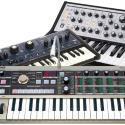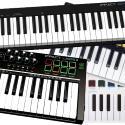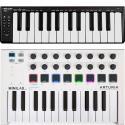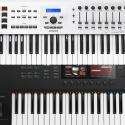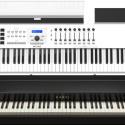Arpeggiator Explained: Musical and Rhythmic Pattern Generator
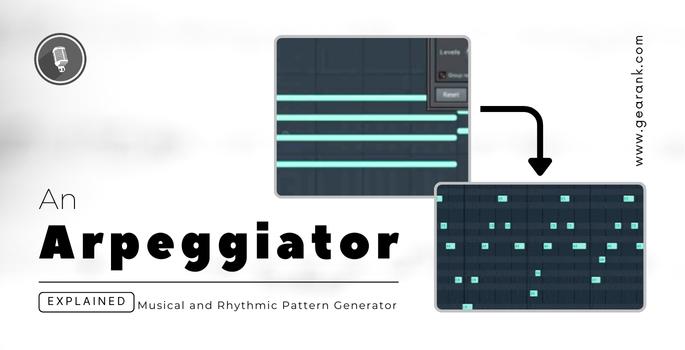
As a musician, you may have faced a situation where your composition has great chords and melody but lacks drive. Fortunately, advanced tools and software can add excitement to your music.
An arpeggiator is one such tool that can come in handy. It allows you to play the notes of a chord one by one, without any overlap, creating complex musical patterns and exciting melodies.
In technical terms, it is a device that produces a series of notes from a single chord by dividing them into individual notes and then playing them in sequence. Arpeggiators are widely used in electronic music to create rhythmic patterns, complex harmonies, and dynamic melodies with just a few notes. They can provide instant inspiration by spicing up otherwise boring chord progressions.
Understanding how an arpeggiator works and its potential applications can take your music to the next level and unleash your creativity.
What Is An Arpeggiator?
An arpeggiator is a software or hardware device that allows you to play chords as a series of individual notes. It can play back each chord note in a sequence rather than simultaneously. The term "arpeggiator" comes from the Italian word "arpeggiare," which means "to play on a harp." However, any instrument can be used to play an arpeggiated chord.
In the past, arpeggiated chords had to be played manually by the performer. Today, there are a variety of synthesizers and arpeggiator plugins available that make the process much easier. These devices allow you to play around with the note order, such as descending or ascending the notes. A separate arpeggiator plugin allows you to arpeggiate virtual instruments that don't come with them.
Arpeggiators work by triggering individual notes of a chord in a specific sequence. The device can be set to a particular tempo and rhythm, allowing you to create complex patterns and rhythms easily. Aside from the basic principles, modern software, and hardware arpeggiators incorporate advanced features like note length control, swing, and shuffle to create unique and dynamic performances.
A Brief History Of Arpeggiators
Arpeggiators have been a significant component of synthesizers since their inception. The history of the arpeggiator is closely intertwined with the early days of synthesizers.
The first synthesizers with built-in arpeggiators were introduced in 1978, and arpeggiators were integrated into hardware synths throughout the 80s and 90s.
The arpeggiator revolutionized music, and its unique sound became ubiquitous in various genres, from rock and pop to film scores. It is now a common synthesizer feature and it's rare to find a synth without one.
Arpeggiators have become an iconic part of music history, particularly in the 1970s, 80s, and 90s. They have been used in many popular songs, including "Girls Just Want to Have Fun" by Cindy Lauper and "Blue Monday" by New Order, which featured synth riff sequences that defined their era.
Arpeggiators also played a vital role in the evolution of dance music, along with sequencers. Arps inspired new styles of music that involved repetitive and precise performances, such as techno and house.
Although many artists today use separate arpeggiator plugins for their effects, the earliest arpeggiators are still highly prized for individual music production.
Common Arpeggiator Patterns
Now that we have established an arpeggiator's origin and functionality, let's dive into the specifics of the different patterns that can be created using this tool.
Creating arpeggios is a straightforward process, as all arpeggiators operate on the same fundamental principles, regardless of whether you are using a free plugin or a synthesizer arpeggiator. By activating the arpeggiator and pressing and holding a chord, the individual notes will be played consecutively in the correct order, resulting in an arpeggiated sequence.
Most arpeggiators come equipped with a latch or hold function that allows the arpeggiator to remember the last chord played, enabling the user to continue playing the same sequence until introducing a new chord. Additionally, various arpeggiators offer different features that allow for creating complex patterns.
The number of notes, the tempo of the arpeggiator, and the length of individual notes are all variables dependent on the desired outcome of the arpeggio, whether it be a classic drum track or a piano roll.
These are some of the most common arpeggiator styles that you can use to create complex melodies and additional rhythmic accents in your music:
Up
Try to play a basic C major chord with the "Up" setting. The musical sequence will be played in ascending order, starting from the lowest note and moving up to the highest one, each being played separately.
Down
It's possible to invert the sequence. By playing a chord with multiple notes, the arpeggiator will trigger each note, starting from the highest and moving downwards to the lowest.
Converge
The arpeggio technique involves playing the root note as the first note, followed by the highest note, then alternating between low and high until reaching the midpoint. This creates a distinct sound that emphasizes the chord's notes and can add complexity to a musical piece.
Diverge
Consider setting it to Random mode if you want to explore more advanced arp features. This will enable it to play individual notes randomly, generating unique patterns based on the chord type you're using.
Random
You can also set your arp to Random which means that it will play individual notes at random. This can create unique patterns depending on your chord type.
How To Use An Arp In Music
Arpeggiators are powerful tools that come built-in with some synths and arp plugins. They can generate a solid main melody or add rhythmic harmonics to your track.
There are also outboard MIDI devices for this, but they are few and far between these days. More often you'll see an arpeggiator as a feature included in digital keyboards, synthesizers, MIDI keyboard controllers, and virtual instruments.
Arpeggiators are versatile and can be used for almost anything you want. Here are some of the most popular ways to use your arpeggiator.
Arpeggiate Every Chord
Arpeggiators are typically incorporated into synthesizers. To properly sequence a chord with your synth, you must first determine its sequencing method.
The capabilities of your synthesizer and keyboard determine the number of notes you can play in a chord.
Pattern Sequencing
Arpeggiators are a powerful tool in music due to the distinctive patterns they create.
When using an arpeggiator, consider the desired pattern, whether descending or ascending, and adjust the arpeggiator parameters accordingly.
When you create arpeggios out of a static chord or a simple chord progression, it might not be enough to generate interest. This is where arpeggiators come in, generating complex musical patterns based on the notes played on the controller.
While most synthesizers offer basic patterns, some models come with custom arpeggiated notes and sequences.
As a result, with arpeggiators, musicians can create intricate patterns and complex sequences that add depth and nuance to their compositions. A sequencer is also a good option, as it allows you to program notes, arpeggiation, and even the entire song if you choose to.
Rhythm Sequencing
Arpeggiators are a highly versatile tool in music production, particularly when creating intricate fills or complex rhythmic patterns. You can even make intense drum fills with clever use of an arpeggiator and a MIDI controller.
Using arpeggiators, you can quickly generate complex eight-note variations and introduce tasteful movement to your compositions.
When you sync the arpeggiator tempo to your DAW or outboard drum machine and choose a different rhythm, you can create interesting patterns that you might not have thought of.
This can significantly enhance your music's overall quality and help you create more intricate and engaging arrangements. You get different notes that you normally wouldn't play.
Extend The Arpeggio Range
Some arpeggiators and synthesizers come equipped with the capability to transpose a single note of your full chords up or down several octaves. This feature enables the creation of sweeping arpeggios that can produce remarkable sound effects. With this, you have control over how many octaves the arpeggio covers.
Background Textures
An effective way to add depth to your music is to use an arpeggiator for background elements. You can duplicate your chord progressions on a separate midi track and select a suitable synth or piano sound.
Next, you can add your arpeggiator and customize the arpeggiator settings. You can then mix it into the track based on your preference. This approach is a great technique to add more complexity and interest to your music.
Final Thoughts
A powerful arpeggiator can elevate your sound from average to extraordinary. It greatly simplifies music production and editing of rhythmic patterns, making it a valuable tool for musicians and producers alike.
When you incorporate arpeggiators into your music production, it can take a simple chord progression and add more movement and dynamics to a part or piece.
It can also speed up your workflow by automatically playing the sequences instead of inputting each note individually.
Although arpeggiators are common in synthesizers, you can also purchase an arpeggiator plugin separately to work on your chord progression without a synth.
Contributors:
Jerry Borillo - Illustrator



